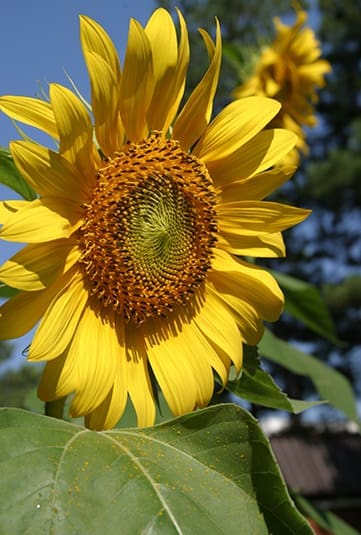 Photo By Michael Alexander
Photo By Michael AlexanderAtlanta
Marist Garden Gives Students Hands-On Lessons
By STEPHEN O'KANE, Staff Writer | Published August 5, 2010
As Georgia’s summer reaches the heights of an August heat wave, Marist teachers Mike Burns and Kevin Lilse continue to tend the Marist Garden in preparation for the new school year.
A quick stroll through the garden, located behind the school chapel, reveals a variety of vegetables and spices, including tomatoes, okra, eggplant, peppers, basil and much more.
While the garden opened last fall, the idea began to germinate several years ago through Burns’ friendship with Marist colleague Tom Zibilich, an accomplished master gardener. Zibilich helped Burns start a garden in his own backyard, and Burns “fell in love with the joys of home-grown produce and the fun and tasty nutrition it provides for my family.”

Okra is one of the many crops grown in the Marist School garden. Beans, corn, eggplant, peas, peppers, potatoes, squash and tomatoes are just a few of the others. Photo By Michael Alexander
Through Zibilich, Burns discovered how powerful it was to grow one’s own food, and he said the idea of starting a garden at Marist seemed like a fun and educational project.
In spring 2007, Burns and Zibilich met with Lisle, a chemistry teacher in charge of the school’s Environmental Club and Green Initiative designed to make the campus more environmentally friendly.
“We all got together and started hashing out the plans, and eventually we worked hard with a group of students and faculty to clear some dormant land adjacent to the school property for a trial garden,” wrote Burns.
“That same fall, Mr. Lisle and I got to go to Berkeley, Calif., for a seminar on school lunches and were able to spend time at the premier school garden, The Edible Schoolyard, started by Alice Waters.”

Growing to heights as tall as 12 feet, sunflowers have a dominant presence in the Marist School garden. Photo By Michael Alexander
Inspired by their Berkeley experience, the aspiring educational gardeners returned to Atlanta and decided to move the location of the garden closer to school classrooms, hoping to catch the interest of students.
With the help of students, parents and faculty, the group broke ground on the garden in fall 2008 and in just two months, they were able to construct a garden of raised beds.
“We couldn’t have done it without the support of the school community,” said Burns.
The all-organic garden, which does not use any commercial fertilizers or chemicals, became official last spring when it became an elective course and the first group of students got credit for helping out. Burns, who teaches English, said there were about 25 students who consistently helped with the garden during the first elective. He hopes even more will join as they prepare to start again this year.
Last year, the Marist gardeners harvested nearly 250 pounds of food, which they donated to the Atlanta Community Food Bank, a tradition they hope to continue. They also hope to begin providing some food for the school cafeteria where the students can see and taste the direct result of having the project on campus.
“We really want to provide food for the cafeteria and for families in need,” said Burns. “It’s a powerful lesson to learn where your food comes from.”
As Burns and Lisle look toward the upcoming school year, they have plans to expand students’ accessibility to the garden, with hopes of starting a dedicated garden club so the students can really take over a lot of the projects.
“We would like to continue using it as a learning lab,” said Burns. “We hope to have a strong winter crop this year.”

The roof of the Marist School chapel provides a wide view of the various flowers and vegetables that comprise the school’s one-year-old organic garden. In the summer of 2009 when the garden was created, dozens of volunteers harvested close to 200 pounds of beans, tomatoes, eggplant, peppers, and other crops. Photo By Michael Alexander
The school recently received a small, donated greenhouse that will be used this year. Burns and Lisle are looking forward to watching this project grow.
“It makes so much sense to be able to use our time and resources to teach the students about issues related to the environment, health, conservation, social justice, science, literature, history,” wrote Burns about the garden.
“You name it, and there’s a way we can connect it to something in the garden. What food we put in our bodies is one of the most important choices we make each day. Also, what we, as educators, put in our students’ minds is also one of life’s most important choices. We think the garden is the perfect way to bring those ideas together.”